The Alfonso XII class were three Spanish masted unprotected cruisers built during the 1880s all in Ferrol. They were named for a Spanish king and two Spanish queens, made in steel, but construction time was very long, and they were obsolete when completed. They were assigned to colonial duty in the Caribbean and Philippines and took part in the 1898 Spanish-American War, in which both Reina Cristina and Reina Mercedes were sunk, one at Manila, the other at Cuba.
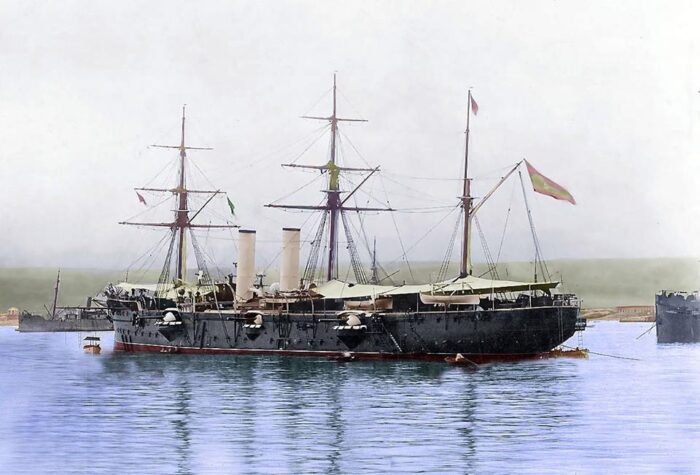
Alfonso XII Colorized by Postales Navales
Design of the class
The Alfonso XII sported three masts and two funnels, they adopted the French-style (Bertin) cellular system for ASW protection for the first time, and were the built in Ferrol as steel-hulled cruisers. They were the product of engineer Tomás de Tallerie, and their purpose was to be assigned, all three, to the Philippine Station. They took a long time to complete, delayed five years due to a shortage of materials, ten years from keel laying to commissioning, but they were originally designed for colonial service and never to take part in any fleet action or against armored ships they could encounter. They were so literally fed to the lions when sent out to fight in the Spanish-American War of 1898.
Hull and general design
These ships were typical of their time, with French style ram bow and clipper style stern and poop, a single rounded rear projecting rudder. The hull had a variable beam from stern to prow, no tumblehome, a forecastle and poop and main battery deck protected by tall bulwarks on either side, over a 3,042 tons displacement, 278 ft (85 m) in length for 43 ft (13 m) in beam, and a draft of 20 ft (6.10 m) max. aft. As said above, by default of a true armour protection, these vessels had an ASW protection constituted by 12 watertight bulkheads. It is not known if they were filled with cork, or optionally coal. They were designed to supplement by rigging their steam range in any case. Superstructures were reduced to a small bridge with wooden paneling in front of the forefunnel. The amidship section was made of large, glassed access hatches to the machinery, with air scoops.
The steel was manufactured at the La Felguera Factory (Asturias), for which it was necessary to assemble a Martín-Siemens furnace, and they were transported by rail to assembly at the Ferrol shipyards.
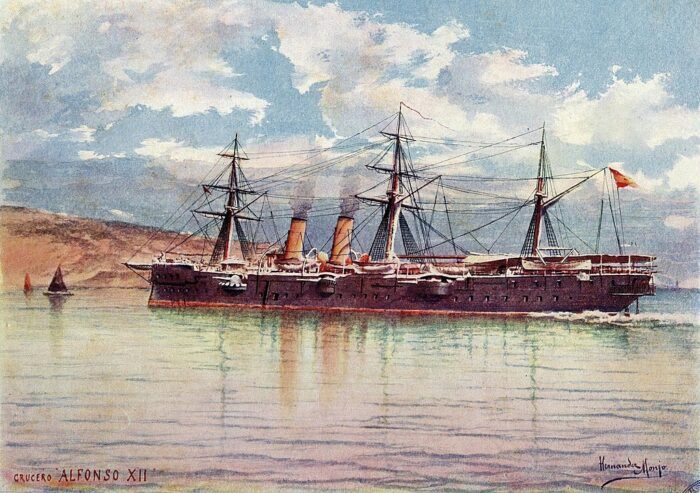
Powerplant

They had a Spanish machinery, single Horizontal Compound (HC) and four cylindrical boilers for 4,400 hp total, truncated into two tall raked funnels amidship. Speed was noted from 15 to 17 kn (31 km/h) on trials, and they had 500 tonnes (720 tons of coal maximum) coal for a steam range of c1000 nm, but they counted on their rigging, with 1.725 m² sail surface between the three masts.
They were plagued however with machinery and boiler problems, proving to be poor steamboats and much slower than their designers anticipated. It’s likely 15 knots was their real speed, 17 their design speed. In any case, the lack of maintenance that plagued them before 1898 robbed them for any improvements. Between their crusted hulls and poor quality coal, they were likely restrained to 12-14 knots at best.
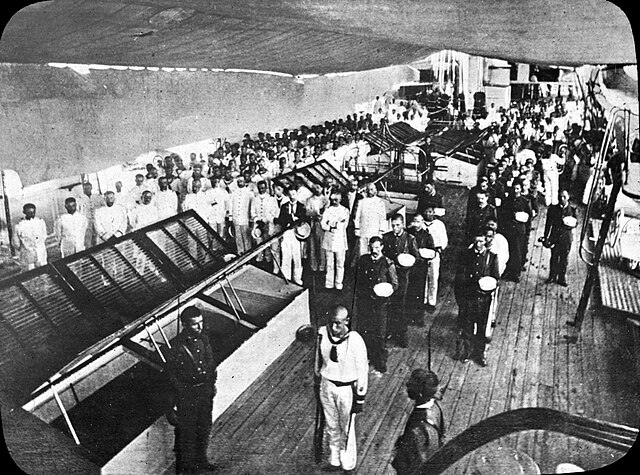
Armament
They were designed to carry Spanish made Hontoria guns mounted on sponsons, six 160 mm and on the poop and forecastle thre 57 mm and two Nordenfelt rapid fire 42 mm for close protection, six Hotcjkiss 37 mm machine guns and two light machine guns that could be transferred to cutters for landing parties.
They also had two torpedo tubes, fixed on each beam, plus one forward and one aft in a lozenge pattern.
Main: González-Hontoria 160 mm (6.3 in)
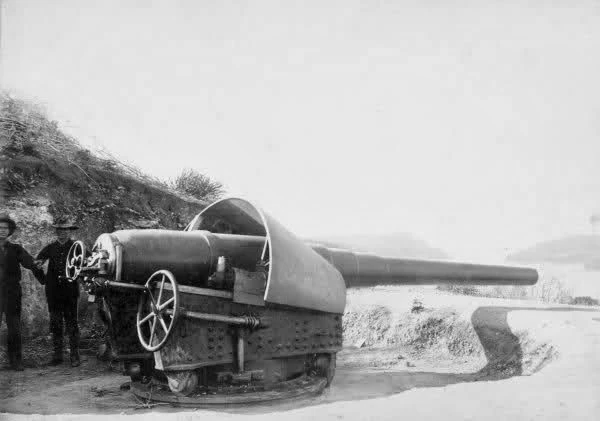
Introduced in 1886, these were designed from the study of imported German, French and British designs. They were produced at the Arsenal de la Carraca in Cadiz and the Royal Ordnance Works at Trubia in Asturias, but criticized as being already obsolete and slow firing. Thus in the 1890s most were converted as QF guns at Schneider. Unfortunately they were kept “in their juice” for the Alfonso XII class. These were placed in positions on the lower battery deck behind tall steel bulwarks protecting their crews from rifle fire and shrapnell. The sponsons allowed them to reach 90° arc forward and aft, almost 180° arc total. Total number of shells unknown. Typical of the Armada in the 1890 they were such in short supply that no practical training could be done.
Specs:
Weight: 6.4 t (7.1 short tons)
Dimensions: Length 5.8 m (19 ft), Barrel 5.6 m (18 ft 4 in) 35 caliber, Height 4 m (13 ft 1 in)
Shell: 51–59 kg (112–130 lb) Separate loading 29 kg (64 lb) smokeless powder bagged charge and projectile
Loading: Breech with Interrupted screw
Muzzle velocity: 618 m/s (2,030 ft/s)
Maximum range: 9.8 km (6.1 mi) at +17.5°
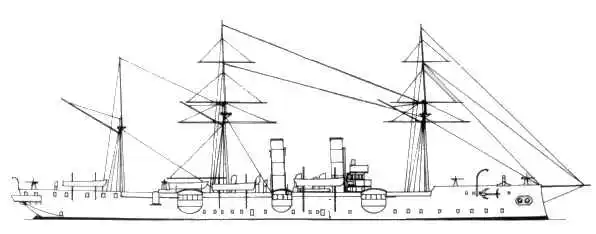
Secondary
All placed on the forecastle deck and poop deck, exact location unknown (i really need to visit Ferrol museum one day)
• 3 cañones de 57 mm: Likely two on the forecastle, one axial on the poop deck. British 6-pounder, 1886 pattern.
• 2 cañones Nordenfelt de 42 mm: Arrangement unknown, with gravity style feed Brass case 42 * 185 R.
• 6 cañones rotativos Hotchkiss de 37 mm: Gatling style, 5 barrel, gravity feed, pivot mounted.

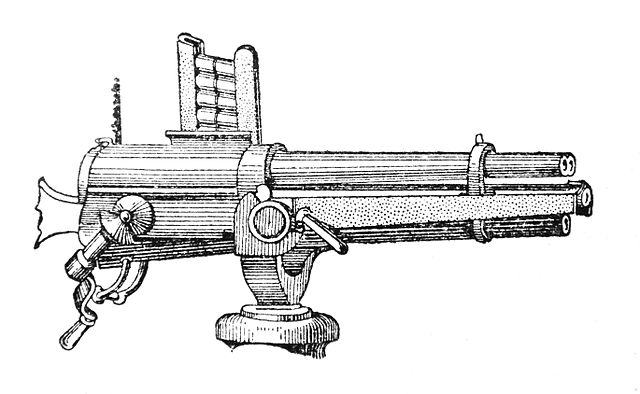
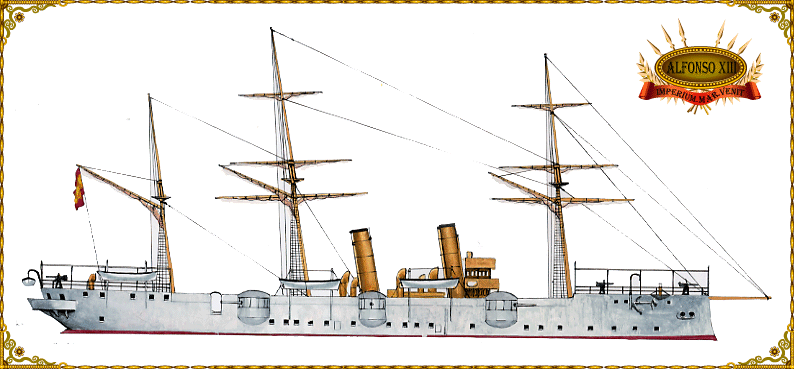
Author’s rendition of Alfonso XII in 1898
⚙ specifications |
|
| Displacement | 3,042 tons |
| Dimensions | 278 x 43 x 17 ft (85 x 13 x 6.10 m) |
| Propulsion | 1 HC steam engine, 4 boilers, 4400 hp |
| Speed | 17 kn (31 km/h) as designed, 15 kts real |
| Range | 500-750t coal, Steam unknown, sail unlimited |
| Armament | 6× 6.4-in (163 mm), 8× 6-pdr Hotchkiss, 6× 3-pdr Hotchkiss, 5× 14-in TTs, see notes |
| Crew | 370 |
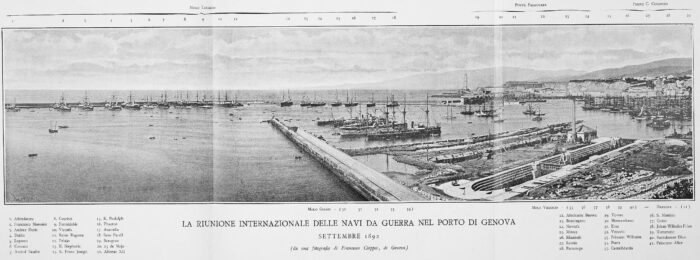
Various international ships at Genoa for a review, including the Spanish cruisers.
Career of Alfonso XII class
 Alfonso XII
Alfonso XII
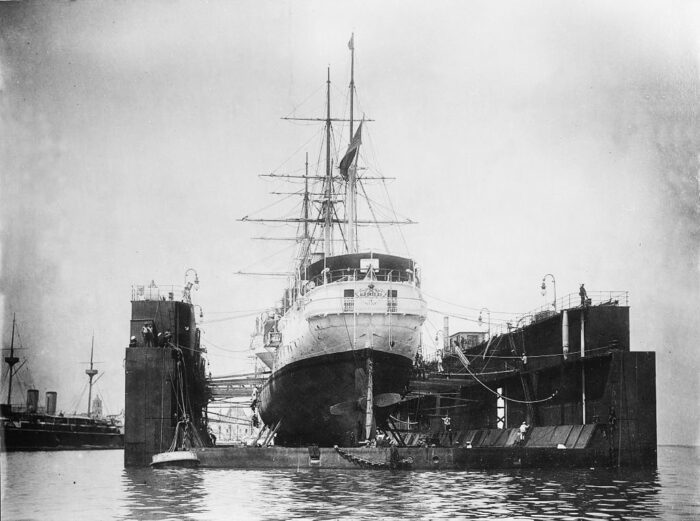
Alfonso XII on the floating dock in Havana in 1898. Note the white hull and old style poop gallery.
Shortly after entering service, Alfonso XII sent to Tangier in response to an incident with Morocco. In 1892 she was present at various events and celebrations at the occasion of the IV Centenary of the discovery of America, including naval reviews of Huelva and Genoa. She also participated in the war of Margallo between 1893 and 1894, part of the first Rif war.
Alfonso 12 was sent to Cuba in October 1895 in order to deal with the insurrection. On the night of February 15, 1898 in Havana, she arrived and started operations by sending landing parties.
Two months later, the war broke up with the US, she stayed in La Havana. Due to her poor steaming capabilities, she was disarmed, her guns transferred on land for the defence of the city against adanvcing US troops. Thus, she took no part in the fight, but was not captured either.
After the war, and signing of the Treaty of Paris article V stated: that Flags and standards, non-captured warships, portable weapons, cannons of all calibers will be the property of Spain, and so did Alfonso by May 1900. By Decree of May 18 that year, the Ministry of the Navy made a full review of the general state of all vessels and 25 were decommissioned because they were considered ineffective, among them Alfonso XII. The report said:
The Alfonso by modern cannons, but by ancient ones, without speed and with no other application than peace services and the fruitless and nominal persecution of smuggling, they consume without any profit, like the Marquis of La Ensenada, a large part of the budget of the Navy, are the cause of great and justified censorship, and only serve to cover with names without any reality the list of an absolutely fictitious squadron.
Once dismantled, her hull was used as a coal depot at the Arsenal de la Carraca (Cádiz). She was sold for scrap in 1907, scrapped in 1908.
 Reina Cristina
Reina Cristina
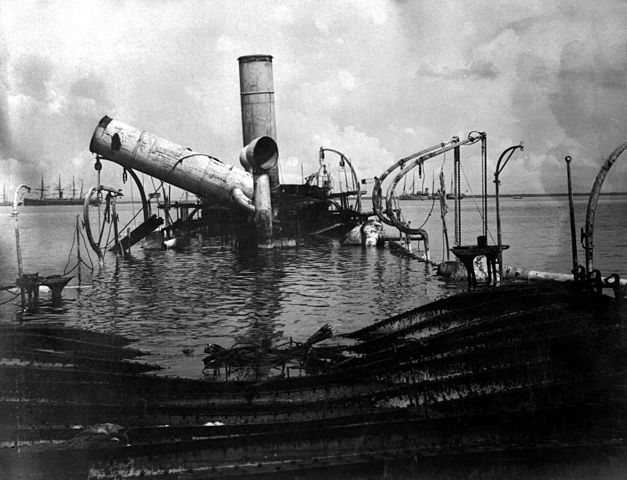
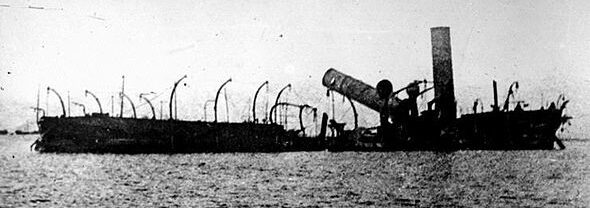
On October 14, 1880, construction was ordered, and she baceme the first large steel warship built in Spain. She was laid down on August 12, 1881 at the Esteiro Ferrol but delays amounted due to the a lack of material. She was launched on May 2, 1886, completed on April 19, 1890.
In 1891, she was assigned to the Philippine Station and remained there throughout her active life. She was deployed to the Caroline Islands during the Carolina Crisis with the German Empire. In the early morning of January 5, 1895 while returning from the bombardment of rebels at Mindanao, she ran aground near Ilo-Ilo, with 2 fatalities and several injuries, but she could free herself was was repaired at Manila.
During the Spanish-American War she became flagship of Rear Admiral Patricio Montojo y Pasarón squadron at the Battle of Cavite, on May 1, 1898, but she was accordingly taken as primary target by the whole USN line. Riddled with shells she had numerous fires and significant damage, numerous casualties, including the commander, Captain Luis Cadarso y Rey (1843-1898). She eventually sank in shallow waters. In 1903 her remains were refloated and scrapped.
 Reina Mercedes
Reina Mercedes

The Reina Mercedes wasthe only one built at the Cartagena Naval Arsenal, launched in September 1887. In 1893 she was stationed at Santiago de Cuba in the training squadron, and in 1895, she was designated as flagship of the Spanish naval forces in Cuba.
In 1898, the poor condition of her boilers due to lack of maintenance, prevented her from operating normally and she was instead assigned as a fixed defense at the entrance to the bay of Santiago de Cuba. Four 160 mm González-Hontoria guns were landed and relocated at the Socapa battery, to complement 300 years old muzzle-loading guns. Once the US fleet arrived off the bay of Santiago de Cuba, plans to lock up the fleet and wait for a favorable outcome inland seemed preferrable in order to capture the entire Spanish fleet intact without firing a shot. In the night of June 2 to 3, the blockade commenced with the USS Merrimac, loaded in order to be scuttled at the entrance, was spotted by Reina Mercedes and the destoryer Plutón, which sank her before blocking the channel.
On June 6, Reina Mercedes came under artillery fire, receiving 35 direct hits.
Eventually it was planned to tow further to the entrance and scuttle her in order to block access to the port.
In early July 1898, as US Army forces advancing overland were about to capture Santiago de Cuba, Admiral Cervera sailed out with his squadron, trying to force the blockade. On July 3, while attempting to escape his forced were completely destroyed in the Battle. On July 4, 1898 Reina Mercedes, released her moorings and headed to the canal when she was spotted before midnight by the battleship USS Massachusetts. She lighted her up, soon battleship USS Texas followed and both opened fire. Reina Mercedes received many hits but she maintained her course and dropped anchor, her crew managing to detonate her sinking charges, while she veered toward the eastern edge of the channel, in a place she could not block it.
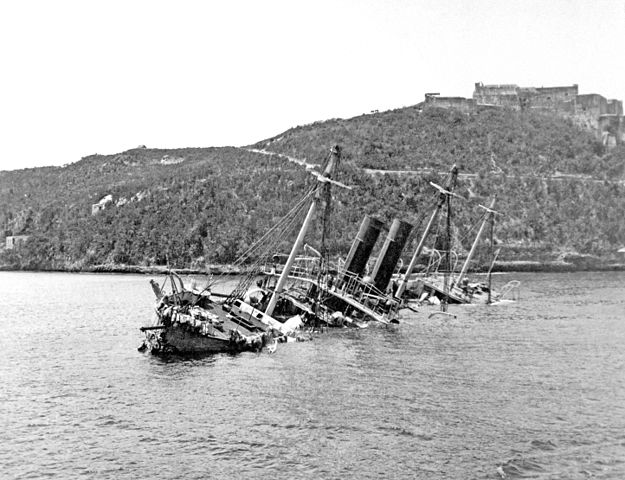
Reina Mercedes was captured by an US party on July 17 after Santiago de Cuba surrendered. She was examined by specialists, refloated between January 2 and March 1, 1899, towed to Norfolk for patching and then Portsmouth Naval Shipyard in Kittery, Maine from August 25, 1900, for full repairs.
Instead of reverting to her cruise role, she was converted into a pontoon boat without propulsion. In 1905 she was stationed at Newport, Rhode Island as depot ship. In 1912 she returned to Norfolk Naval for conversion into a stationary accommodation ship for the Annapolis naval academy, and became the IX-25 cadet accommodation ship. In 1920 during the visit of the battleship Alfonso XIII to Annapolis she briefly flew the spanish flag as a welcome.
In 1954, the new ambassador of Spain to the United States, José María de Areilza, started efforts to have her returned to Spain but did not succeed. Franco’s Spain started to gain support in the American government and after the Madrid Pacts of 1953, Areilza managed to gather enough support, including from President Eisenhower to have her scrapped in 1957 in Baltimore, wherehas her bell was returned to Spain. She was decommissioned in a ceremony attended by ambassador Areilza.
Read More/Src

Links
spanamwar.com/Reinacristinacanvas.htm
spanamwar.com/AlfonsoXii.htm
spanamwar.com/reinam.htm
navypedia.org/ alfonso_xii.htm
laststandonzombieisland.com cruiser-reina-mercedes/
alojados.revistanaval.com alfon12.htm
todoavante.es/ Reina_Mercedes
web.archive.org/ history.navy.mil/photos/ alf-xii.htm
todoavante.es Alfonso_XII_(1891)
web.archive.org/ history.navy.mil r-merced.htm
web.archive.org/ usna.edu
abc.es/historia-militar/ reina-mercedes
gehm.es/ crucero-reina-mercedes/
commons.wikimedia.org/ Reina_Cristina_class
en.wikipedia.org/ Alfonso_XII-class_cruiser



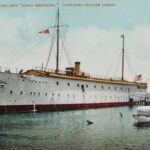
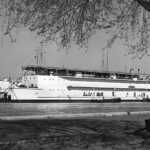
 Latest Facebook Entry -
Latest Facebook Entry -  X(Tweeter) Naval Encyclopedia's deck archive
X(Tweeter) Naval Encyclopedia's deck archive Instagram (@navalencyc)
Instagram (@navalencyc)





 French Navy
French Navy Royal Navy
Royal Navy Russian Navy
Russian Navy Armada Espanola
Armada Espanola Austrian Navy
Austrian Navy K.u.K. Kriegsmarine
K.u.K. Kriegsmarine Dansk Marine
Dansk Marine Nautiko Hellenon
Nautiko Hellenon Koninklije Marine 1870
Koninklije Marine 1870 Marinha do Brasil
Marinha do Brasil Osmanlı Donanması
Osmanlı Donanması Marina Do Peru
Marina Do Peru Marinha do Portugal
Marinha do Portugal Regia Marina 1870
Regia Marina 1870 Nihhon Kaigun 1870
Nihhon Kaigun 1870 Preußische Marine 1870
Preußische Marine 1870 Russkiy Flot 1870
Russkiy Flot 1870 Svenska marinen
Svenska marinen Søværnet
Søværnet Union Navy
Union Navy Confederate Navy
Confederate Navy Armada de Argentina
Armada de Argentina Imperial Chinese Navy
Imperial Chinese Navy Marinha do Portugal
Marinha do Portugal Mexico
Mexico Kaiserliche Marine
Kaiserliche Marine 1898 US Navy
1898 US Navy Sovietskiy Flot
Sovietskiy Flot Royal Canadian Navy
Royal Canadian Navy Royal Australian Navy
Royal Australian Navy RNZN Fleet
RNZN Fleet Chinese Navy 1937
Chinese Navy 1937 Kriegsmarine
Kriegsmarine Chilean Navy
Chilean Navy Danish Navy
Danish Navy Finnish Navy
Finnish Navy Hellenic Navy
Hellenic Navy Polish Navy
Polish Navy Romanian Navy
Romanian Navy Turkish Navy
Turkish Navy Royal Yugoslav Navy
Royal Yugoslav Navy Royal Thai Navy
Royal Thai Navy Minor Navies
Minor Navies Albania
Albania Austria
Austria Belgium
Belgium Columbia
Columbia Costa Rica
Costa Rica Cuba
Cuba Czechoslovakia
Czechoslovakia Dominican Republic
Dominican Republic Haiti
Haiti Hungary
Hungary Honduras
Honduras Estonia
Estonia Iceland
Iceland Eire
Eire Equador
Equador Iran
Iran Iraq
Iraq Latvia
Latvia Liberia
Liberia Lithuania
Lithuania Mandchukuo
Mandchukuo Morocco
Morocco Nicaragua
Nicaragua Persia
Persia San Salvador
San Salvador Sarawak
Sarawak Uruguay
Uruguay Venezuela
Venezuela Zanzibar
Zanzibar Warsaw Pact Navies
Warsaw Pact Navies Bulgaria
Bulgaria Hungary
Hungary

 Bundesmarine
Bundesmarine Dutch Navy
Dutch Navy Hellenic Navy
Hellenic Navy Marina Militare
Marina Militare Yugoslav Navy
Yugoslav Navy Chinese Navy
Chinese Navy Indian Navy
Indian Navy Indonesian Navy
Indonesian Navy JMSDF
JMSDF North Korean Navy
North Korean Navy Pakistani Navy
Pakistani Navy Philippines Navy
Philippines Navy ROKN
ROKN Rep. of Singapore Navy
Rep. of Singapore Navy Taiwanese Navy
Taiwanese Navy IDF Navy
IDF Navy Saudi Navy
Saudi Navy Royal New Zealand Navy
Royal New Zealand Navy Egyptian Navy
Egyptian Navy South African Navy
South African Navy






























 Ukrainian Navy
Ukrainian Navy dbodesign
dbodesign